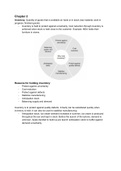Samenvatting
Summary of International supply chain management 2 (ISCM) | AMSIB year 2 | HvA
- Instelling
- Hogeschool Van Amsterdam (HvA)
A detailed summary of the final ISCM exam in year 2 of the study of international business given at AUAS (HVA). Chapters covered: - 2, 7, 9, and 11 of the book Guide to supply chain, C. Scott, H. Lundgren, P. Thomson - Chapters 5, 6, and 7 of the book Export management, H. veldman
[Meer zien]





